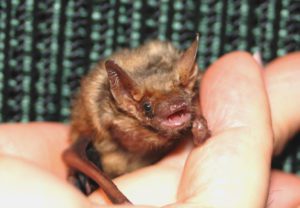Her name makes you think of a festive holiday plant – shiny green leaves and bright red berries – not an empty aquarium, garbage bags and disdain for an animal in need. She arrived on Christmas Eve of 2006, a pipistrelle bat—the smallest species in N. America, less than one inch in length and weighing no more than a dime. She was in a 10 gallon aquarium enclosed in two black plastic garbage bags that were sealed with duck tape. She lay there, wet and shivering, mud oozing from her delicate wing membranes as she gasped for air.
When we asked the folks who brought her why they put her in such a large container and sealed it so tightly, they looked replied, “Well it’s a bat”. After cutting away the duct tape to remove Holly, we motioned to the aquarium and assured them they only had to wash it and it would be reusable. The reply was, “No, no, we do not want anything back that the bat touched.” Misconceptions abound, but at least they saved her from her watery grave. Their 9 year old son, who actually discovered Holly, had learned from his teacher that if you find a bat, you should get it help. As it was Christmas Eve, a child’s pleading with his family could not be ignored. He said that he held the aquarium in his lap during the car ride over and kept asking God to help save the little bat. He said, “I also told my Mom to drive faster because I knew you would be able to help.”

It took several months, but Holly completely recovered. Unfortunately, her broken bones left her too severely compromised to be released. Holly has adapted well to a captive care life. She established territory in the natural habitat enclosure she shares with Mexican free-tails, big browns, and evening bats. Pipistrelles, unlike other species of bats, roost both in trees and crevices in the wild.
Holly was with us until January 28th of this year, residing at our rescue center Bat World Lone Star. She showed no signs of being ill beforehand and appeared to have passed away in her sleep from old age. We estimate that she was approximately 12 to 14 years old. Holly was such a little trooper and survived tremendous odds, and she will be forever missed.


